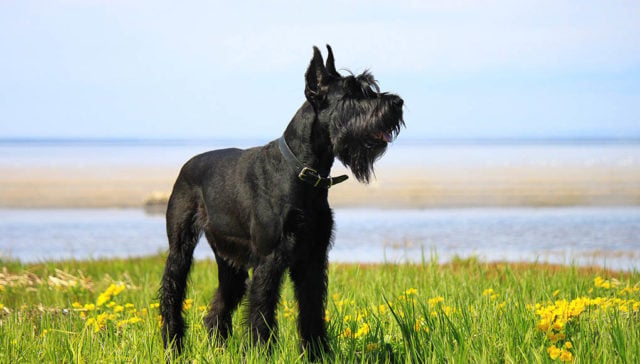
Table of Contents
The Giant Schnauzer dog breed ironically isn’t the largest of them all but they are the largest breed in the Schnauzers family.
Their strong build, large stance, intelligence, and athletic abilities helped build their reputations as working dogs.
They are large indeed and their personality matches their size as well. In this blog, you will learn all there is to know about Giant Schnauzers.
This complete dog breed profile will also help you determine whether a Giant Schnauzer is a suitable dog for you!
Giant Schnauzer: Overview
Giant Schnauzers are known for it’s working ability and their loyalty. They are very sensitive, protective, and territorial.
Germans have given their name ‘Riesenschnauzer’ which means the giant.
From breeding Standard Schnauzers to other breeds such as Drovers, Great Danes, and other large breeds, it became possible to create the Giant Schnauzers dog breed.
In addition, when it comes to adopting a Giant Schnauzer puppy, never buy from a puppy mill, pet store, or an unknown breeder. It is best advised to research and look for a reputable breeder or a rescue group.
So without further a do, let's discuss this dog's characteristics, health, grooming, and more!
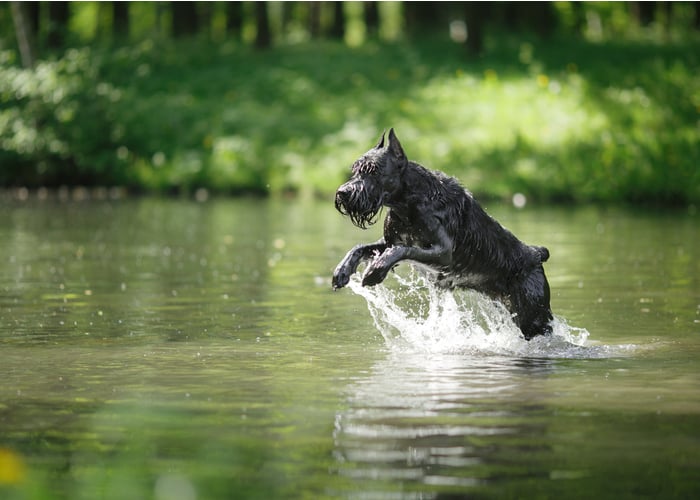
Physical Characteristics
Their head structure is rectangular in appearance as well but with a slimming point from the ears to the eyes. Female and male Giant Schnauzers may differ in the size of heads but is quite according to their body.
Giant Schnauzer’s muzzle is aligned and equal in length from their top skull and ends in an uncurved manner. Their lips are parallel and do not overlap.
Their nose is large and the color is usually full black. Giant Schnauzer’s ears are medium in length. They can be cropped and left uncropped.
Usually, when cropped, the shape of the face lines up from their ears to their muzzle — pointy and proportionately edgy as their facial structure. When left uncropped, their ears are quite high that it falls near to their head.
Giant Schnauzer’s eyes are quite deep and dark in color. They have oval-like shaped and medium-sized eyes as well. The eyebrow hair may need trimming if it falls under the eyes.
Giant Schnauzer's neck is thick and quite long. The skin around their neck sticks well around the throat and gives a fit appearance.
The neck arched smoothly towards the body. The body is dense and strong.
Their shoulder and chest are proportional to their fit body. The distance between the last rib and pelvis is shorter than average but this feature helps with their utility.
Its tail is quite quick that exceeds expression when they're happy. Giant Schnauzers have dense and double-coat features.
The hair is an overall double-coat except around the head. The head includes coarse hair and, of course, their hallmark for having a heavy harsh beard on their brows and beard.
Their standard color is black, pepper, and salt but they also come in black and tan, and fawn.
Height and Weight
Giant Schnauzers resemble Standard Schnauzers but with a bigger build. They have a tall, large and muscular structure with a square proportion. Male Giant Schnauzers can reach 25.5 to 27 inches in height while female Giant Schnauzers may reach 23.5 to 25.5 inches in height. They can weigh up to 95 pounds.
Giant Schnauzer Dog Breed Temperament
Giant Schnauzers are abundantly fond of their family. They prioritize their family’s safety and security. If they sense any danger, they may react as quickly as possible.
Giant Schnauzers may be dangerous for homes with small children. They can be around them but they shouldn’t be left alone.
Of course, their large stature and extensive energy aren’t the best combinations for children. To avoid any accidents and injuries, it’s best to keep them supervised when there are children present.
Children can be uninterruptable and some actions may be perceived as uncertain for the dog. Informing your children ahead not to approach the dog easily can also help in avoiding accidents.
Giant Schnauzer is okay with strangers but they need a careful introduction with them before they trust them as well.
They are territorial. They are not welcoming with other dogs as much. Since they work as guard dogs as well, they tend to be extremely vigilant and territorial of their surroundings.
They may tend to attack same-sex dogs to assert dominance. Training Giant Schnauzers can help modify this behavior.
Their adaptability level is high as well. They can work and be family dogs at the same time. As long as their needs are given every day, they have no problem adjusting to their environment.
Giant Schnauzers are for seasons kind of breed. They can tolerate cold seasons and warm seasons. They can live in colder regions as well.
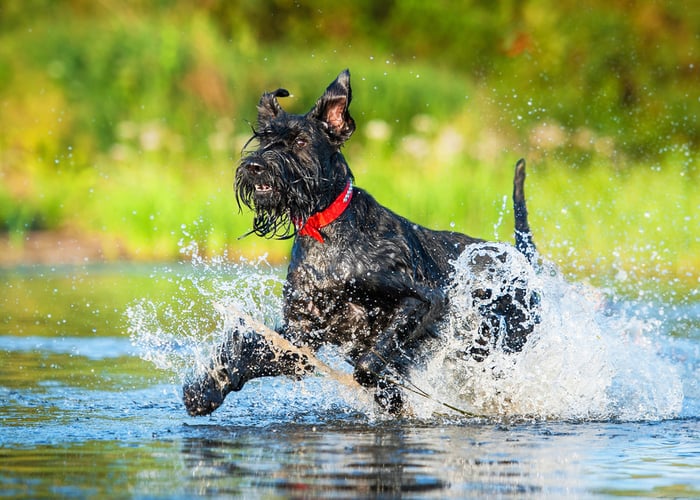
Living with a Giant Schnauzer
This breed may not be the best option for you and the dog if you live in an apartment. This large breed needs a lot of physical activity and space.
Although if you are up for the challenge to bring them out every day for their daily needs, the dog’s condition may compromise.
Giant Schnauzers may require large living space with large backyards for a run and playtime.
The Giant Schnauzer dog breed living in confined or limited spaces may become destructive and depressed if not given their needed physical and mental exposure.
This breed is best not left alone at all. You can leave them in a daycare or someone the dog is familiar with when leaving for a while. They can be easily stressed when they are not present with their family.
Giant Schnauzers are known for their hard-working personalities. They have a background in helping farmers drive cattle from one place to another.
They have a reputation for working quite well as military dogs, police dogs, rescue dogs, and search dogs.
RECOMMENDED: 14 Best Watch Dog and Guard Dog Breeds
Training & Exercise of the Giant Schnauzer Dog Breed
Giant Schnauzers are highly trainable. They are bred to be working-guard dogs.
This breed excels in most sports, which includes agility, obedience, herding, and coursing ability courses as well.
Giant Schnauzers are quick to work and train. As that said, it’s best to interchange their activities, training, or exercises now and then. Their intelligence may bore them with repetitive training.
Giant Schnauzers require constant mental and physical stimulation. They are very intelligent. Training them firmly and routinely can help stimulate them mentally.
Introducing their work and a variety of activities can also stimulate them. They are intelligent and athletic.
They can be given work as an activity or exercise. This can help stimulate both mental and physical needs.
Giant Schnauzers are extremely vigilant dogs. Training them at an early age can help them adjust and adapt their behaviors in recognizing and welcoming new people, things, places, situations, and other animals.
Giant Schnauzers have plentiful energy. Yes, quite a lot of energy and much more than other dogs.
So if you don’t want them bursting their energy indoors while you’re asleep, it’s best to have them exercise daily. Exercising them for 45 minutes to an hour daily is good.
These dogs are highly athletic as well. If their owners enjoy sports or outdoor activities such as swimming, hiking, or running, Giant Schnauzers can match your energy in that.
Spending their energy on long walks can be a part of their exercise regimen. Hide and seek, fetch, frisbee and catch-ball can also be the perfect activity for them.
If they have another dog companion they can spend time and play with, that’s another way of exercising energy for them.
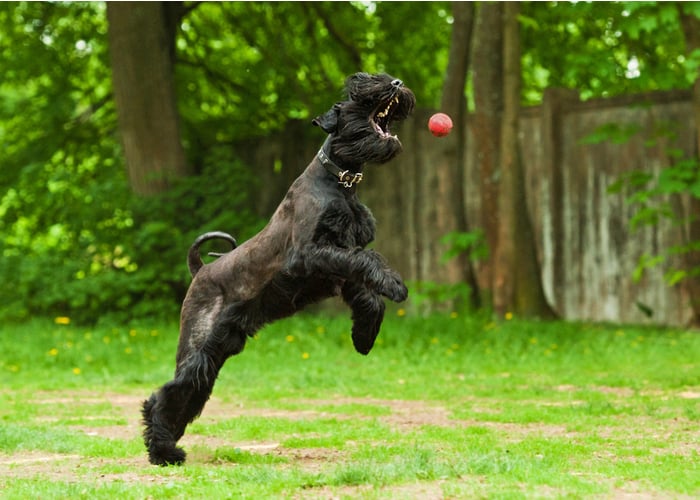
Health Care
Due to breeding other dog breeds along with schnauzers, some genetically inherited diseases from large breeds have been acquired by this breed.
Giant Schnauzers are prone to:
- Osteochondrosis Dissecnas (OCD)
- Hip Dysplasia
- Autoimmune Thyroiditis
Osteochondrosis Dissecnas (OCD)
OCD is usually found in the elbows but it can also be seen in the shoulders. This disorder can cause a painful stiffing of the joint where they can't be able to bend their elbow.
The causes of this disorder are the improper growth of cartilage in the joints and it can also be hereditary. That's why it's important to find a responsible breeder that can show you the health records of the pup's parents for reference.
Hip Dysplasia
Hip dysplasia is a genetic condition wherein the socket of the joint and ball becomes distorted. Giant Schnauzer’s large stature and their mass stress their lower body areas, especially in their joints.
When diagnosed with hip dysplasia, it’s important to keep their weight in the normal range and have them exercise with activities that promote joint therapy.
Veterinarians may prescribe medications for anti-inflammatory/ pain relievers and supplements.
Autoimmune Thyroiditis
This is a hereditary disease. The thyroid gland may produce fewer hormones than needed to function.
Infertility, obesity, and dullness can be the obvious symptoms. Having it checked out and tested early with the veterinarian is the key to treatment and prevention.
To make sure their health is in shape, regular visits and check-up is the best option for this pet.
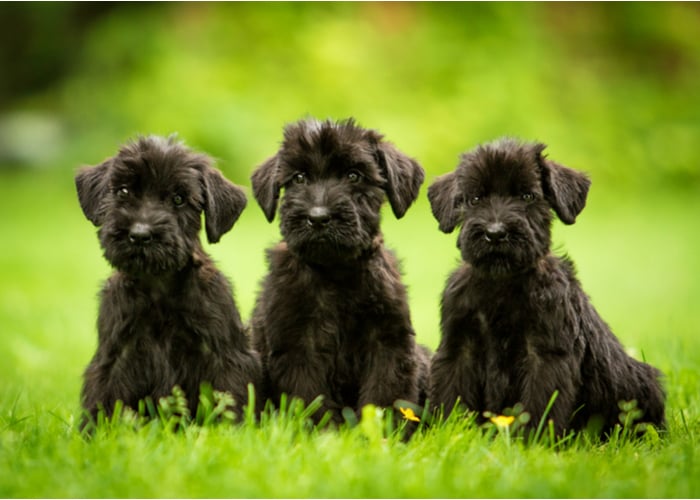
Giant Schnauzers Diet
The Giant Schnauzer dog breed requires a high-quality diet from their puppy stage to seniorhood. Since their in a large breed category, their food intake may be more than usual but they must get to exercise as much as the food they get.
Three to four cups of high-quality dog food divided into two to three meals can suffice the whole day. You can mix wet food into their diet as well for a more diverse meal.
Of course, not all dogs have the same metabolism. Some dogs may gain weight easier, and some not as much.
Keep track of their weight for the meals you give and observe if there are any changes or not. If there are unusual weight changes, it’s best to consult with your veterinarian.
During training, treats can be a tool to influence behavior but keep in mind the amount and frequency as well. Excessive treatment may cause obesity.
It’s important to keep their weight within the normal margin. Large dogs are prone to joint and bone complications which may become worse if they're overweight.
Other than checking with the veterinarian for any allergies or food to watch out for, there isn't much restriction to their diet.
It’s important to get your Giant Schnauzers from licensed breeders. Some breeders have their Giant Schnauzers studded without having it consulted with a veterinarian for diseases or disorders that can be inherited.
Grooming
This breed does not only has a body built for utility but it also has features that help them function with it. Giant Schnauzer has a wiry and double type of coat.
Their double coat helps regulate body temperature depending on the seasons. This double coat consists of a soft and dense inner coat.
Their outer coat is loose and long. Because of this, Giant Schnauzers require frequent grooming.
Since they shed quite often, Giant Schnauzers need to be stripped at least every four to five months. They will require weekly brushes to reduce grime and regulate coat health.
Giant Schnauzers may also need frequent clipping to maintain their coat health. They should be given a bath every month.
They drool but not as much. With their beard feature, it is best to keep their beard dry when you can. Wiping their face after a meal can also help.
Grooming should be introduced early with Giant Schnauzers. Making their grooming experience positive can help them concede with the activity as unharmful. Treats and positive reinforcement can help.
By brushing their hair casually while spending time with them, they can register the activity as affection rather than a routine. This can also help make the grooming less laborious.
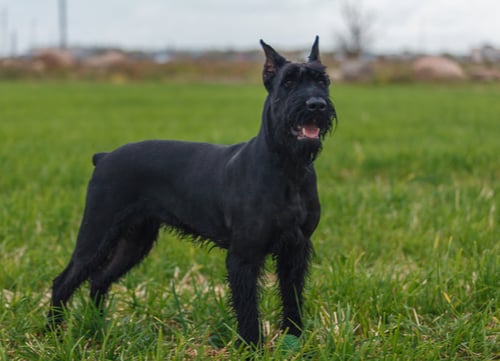
Frequently Asked Questions
Is a Giant Schnauzer hypoallergenic?
Yes, these giants are indeed hypoallergenic dogs. Their coat doesn't shed excessively. That's why fur is not a big concern in owning a Giant Schnauzer.
What are Hypoallergenic dog breeds you ask? Firstly, no dog breed is 100% hypoallergenic or allergen-free.
But hypoallergenic dogs are breeds that are less likely to stimulate allergies to people.
Can Giant Schnauzers be left alone?
Yes, Giant Schnauzers can be left alone for a few hours due to their independence. However, if they are left alone for too long, it can lead to boredom.
This boredom can result in destructive behaviors such as excessive barking, digging, and chewing.
How much is a Giant Schnauzer?
If you're looking to adopt a Giant Schnauzer, remember that getting a dog is not an easy task and it will be costly. Adopting a Giant Schnauzer can range up to $500.
But if you're looking to adopt from a specialist breeder, this breed can range from $1,200 to $3,500.
Giant Schnauzer Dog Breed: Summary
If you're looking for a strong, large, and intelligent dog breed, the Giant Schnauzer might be the dog for you. This breed is known for its working capability and loyalty.
These courageous dogs need the proper training, exercise, and attention to truly excel and live a healthy life.
They have high energy and thrive in homes with big spaces to run and get plenty of their needed exercise.
Just like any other dog breed, Giant Schnauzers need early socialization when they're still young.
Exposure to different environments, animals, and people can help a Gian Schnauzer Puppy grow to be a well-rounded dog.
READ NEXT: 35 LARGEST DOG BREEDS IN THE WORLD












